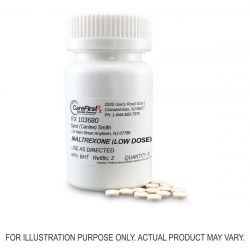Low Dose Naltrexone (LDN) for Fibromyalgia
When you hear the word naltrexone your first instinct is most likely to think of this medication as something that is used to treat opioid or alcohol dependence. However, what if I were to tell you that patients suffering from fibromyalgia could use this medication to find relief and treat their pain? As strange as this may sound, breakthroughs in research in the recent years have actually shown that low dose naltrexone (LDN) may potentially have a multitude of uses, including treating autoimmune diseases, pain and central nervous system disorders. This article will explore why low dose naltrexone (LDN) may not be such a far-fetched idea for treating fibromyalgia.
What is naltrexone?
So what exactly is naltrexone? Naltrexone is an opiate blocking medication, commonly referred to as an opiate agonist. In other words, this medication blocks the effects of opioids by competing to bind to opioid receptors in your body. This medication has been used for many years to safely treat patients suffering from opioid and alcohol dependence. Naltrexone is generally well tolerated however potential side effects may include abdominal pain, nausea and vomiting, and restlessness. Naltrexone should be avoided in patients with liver failure and those who are currently taking or dependent on opioids.
Low dose naltrexone (LDN) vs. high dose naltrexone?
Typically naltrexone (an orally available medication) is prescribed in doses of 50 mg/day or higher for the treatment of opioid and alcohol dependence. However, studies have confirmed that lower doses of naltrexone (3 to 5 mg) decreases symptoms with certain diseases. These diseases included Chron’s diseases, multiple sclerosis, and fibromyalgia.
What is fibromyalgia?
Fibromyalgia is a devastating disease that affects your muscle and bones and causes extreme pain, fatigue, insomnia, and memory and mood issues. These symptoms can decrease the quality of a person’s life tremendously. Unfortunately, the exact causes of fibromyalgia are not known.
Researchers believe that those suffering from fibromyalgia may have extra sensitive microglia and subsequently, their central nervous system (CNS) may have increased inflammation. Microglia are important cells in our CNS, which are crucial to the proper functioning of the immune system. Once these cells become stimulated they set off a chain of events in your body and they release chemicals, which encourage the inflammatory process. This activation results in symptoms of fatigue and increased pain sensitivity, which are common complaints in patients with fibromyalgia.
How can low dose naltrexone (LDN) be used in fibromyalgia?
We don’t really know the exact way in which low dose naltrexone (LDN) decreases symptoms of fibromyalgia. But, the proposed mechanism of action is that it weakens the inflammatory process and therefore decreases the pain associated with this disease. Scientists believe that naltrexone represses the action of the microglia cells. By hindering the effects of the microglia cells there is a reduction in the severity of the symptoms associated with fibromyalgia.
Where is this medication available?
Naltrexone is currently only commercially available as 50 mg tablets, thus lower doses of this medication need to be compounded by a specialty compounding pharmacy. Compounding pharmacies can work with your doctor to customize this medication for you.
References:
- Younger J, Noor N, McCue R, Mackey S. Low-dose naltrexone for the treatment of fibromyalgia: findings of a small, randomized, double-blind, placebo-controlled, counterbalanced, crossover trial assessing daily pain levels. Arthritis Rheum. 2013 Feb;65(2):529-38. doi: 10.1002/art.37734. PubMed PMID: 23359310.
- Fibromyalgia. Mayo Clinic, 2017. Available from: https://www.mayoclinic.org/diseases-conditions/fibromyalgia/symptoms-causes/syc-20354780
- Naltrexone. [package insert]. Mallinckrodt Pharmaceuticals, MO; 2017.










Comments